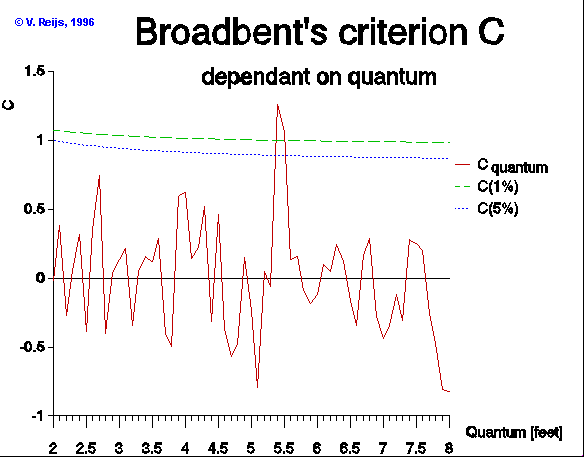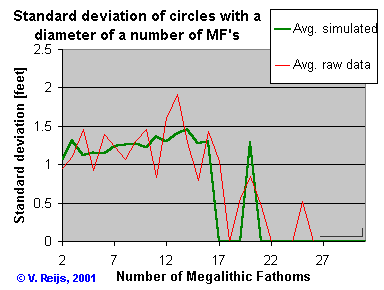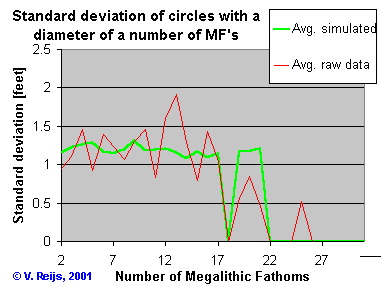 Home
Home Up
Up Search
Search Mail
Mail
NEW
Megalithic measures by Thom
Megalithic Fathom
Thom came to the conclusion that the megalithic yard was a universal
yard stick, distributed by certain people to make sure that buildings
were build using this common yard stick. I have the idea that this
megalithic yard is more based on the human proportions.
The stone circle diameter data provided (Thom [1967],
table 5.1, pages 37-39) has been evaluated with the proposed
statistical
method of Broadbent (1955, 1956). The category within that method used,
was named Case IIb, which means:
- No a priori knowledge of some periodicy in the diameter
- The offset (b) may be different from
zero
Using this method on the data, one gets the following results:

This picture tells us when a possible periodicy (quantum) provides
statistical
confidence (when Cquantum>=C(1%)~1). So using the table
of measured
diameters from the Thom book, this happens at 5.44 [feet]. Thom calls
this
length the Megalithic Fathom (1967, page
41).
Analyzing this deductions, I come to the following issues:
- Thom makes the b (the y-axis offset)
equal
to
zero, but using category Case IIb, one sees a b
of some 0.3 [feet], this is not zero compared to the so called
Megalithic
Fathom (which is 5.44 [feet])!
- Did Thom measure the radius or the diameter of the circles? It is
very
important to know, because depending on the method, the variation will
be different. It is expected that he measured the diameter (see also
text
with table 5.1 of him).
- Thom deducts (page 41) from the fact that:
radius = diameter / 2
that
megalithic yard = Megalithic Fathom / 2
The question is, is one allowed to do this on statistical grounds!?
I would say no, because diameters are measured by Thom and not
radius.
If he had measured the radius then perhaps the megalithic yard would
have
popped up.
Remember that determining the radius is not easy! One has to know where
the center of the circle is and this introduces another error. - One
is perhaps allowed to divided by two, if it is for sure that
neolithic
man made a stone circle by using a string and a pin in the ground at
the
center. If the length of the string (the radius) was set out with the
help
of the megalithic yard, then the diameter would be set out by a
Megalithic
Fathom.
- I think Thom should not have divided the Megalithic Fathom by two
(there
is no valid reason for that!). The Megalithic Fathom should have been
good
enough. Other people (like Kendall, Freeman and Barnatt and Moir) have
found a measure that is coparable to the MF.
- Hawinks G. (Beyond Stonehenge [1973], page 241) assumes that
people
linking hands wirst to wirst will average double the meglalithic yard
of Thom. This is comparable to my ideas.
- A good natural standard is available for determining the
Megalithic
Fathom,
see my explanation.
In the below I only use the Megalithic Fathom, because there are no
valid
arguments available for the megalithic yard.
- Some calculations have been done using the data set of Thom
(table
5.1).
This data set has been used as the base to calculate the standard
deviation
(using Monte Carlo analysis) . The following is analyzed:
- The raw data set of Thom is used.
The
standard
deviation has been calculated for every group of circles that were
build
with an equal number of quantum's (blue). (C5.44~ 1.3). Also
a Monte Carlo analyses (the average is taken over 23 runs) is
determined
assuming an s of 0.33 foot (table 5.1) in
the
circle diameter (red). (C5.44 ~ 1.3)

- The same distribution of number of quanta in the circle
diameter as above.
The quantum is now the human height (5.40, s=0.095
ft) and it includes an overall variation (b=0,
s=1.15 ft). The behavior of the average standard deviation using
Monte Carlo analysis (dark green) and the average standard deviation of
the raw data (red) are almost same (the averages are taken over 23
runs).
(C5.40 ~ 1.1)

- If using
a standard rod (5.440, s=0.003
ft) with an overall variation (b=0, s=1.3
ft).
The following standard deviation is gotten (light green): (C5.44
~ 1.5)

So comparable standard deviations and correct Broadbent values are
delivered
in both cases using a standard length. So a standard (like a standard
rod:
5.440, s=0.003 ft or the human height: 5.40, s=0.095
ft) and a random uncertainty (e.g. due to width of standing stones:
s=1.3
or 1.15 ft) gives comparable results as the measured
circle
diameters by Thom, and using the Megalithic Fathom (and not the
megalithic yard).
- Is the Broadbent method still the best way to deal with periodicy
(quantum's)
in measurements? Or are there already better methods available?
If people have ideas on the above things, please let me
know.
Megalithic inch
Thom also looked at smaller measures than the Megalithic Fathom and
megalithic
yard. One of them was the megalithic inch. He has found this from
measurements
provided in his book Megalithic remains in Britain and Brittany
(from cups and rings). He found that the megalithic inch was 0.817
inch.
By using the same data and the Broadbent method (1955, 1956), in the
below picture one can see the value C, that determines the likeness of
a possible quantum.

There is no real likeness of a quantum at 0.817, but another strange
thing is that Thom now does not use the factor two that has been
discussed
in the above section!
A paper that discusses the megalithic inch (by Alan Davis, paper in
Records
in stone), finds beside 1 MI also quantum's of close to 3 MI and
close
to 5 MI (1% probability level).
He also provides an other idea, supported by me, why 3 MI, 5 MI, 1
MI, 1 MY, etc. could be common:
Alternatively, one might justifiable argue that the 5 MI quantum
is very close to the mean width of a human hand, and interpret 1 MI as
a mean finger width. It would be extremely difficult, if not
impossible,
to distinguish between these two hypothesis on the basis of present
data.
I fully agree with this statement!
Related link
Disclaimer and Copyright
 Home
Home Up
Up Search
Search Mail
Mail
Last content related changes: January 10, 1996




